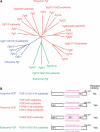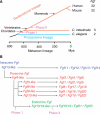Fibroblast growth factors: from molecular evolution to roles in development, metabolism and disease
- PMID: 20940169
- PMCID: PMC3106964
- DOI: 10.1093/jb/mvq121
Fibroblast growth factors: from molecular evolution to roles in development, metabolism and disease
Abstract
Fibroblast growth factors (FGFs) are a family of structurally related polypeptides that are essential for embryonic development and that function postnatally as homoeostatic factors, in the response to injury, in the regulation of electrical excitability of cells and as hormones that regulate metabolism. In humans, FGF signalling is involved in developmental, neoplastic, metabolic and neurological diseases. Fgfs have been identified in metazoans but not in unicellular organisms. In vertebrates, FGFs can be classified as having intracrine, paracrine and endocrine functions. Paracrine and endocrine FGFs act via cell-surface FGF receptors (FGFRs); while, intracrine FGFs act independent of FGFRs. The evolutionary history of the Fgf family indicates that an intracrine Fgf is the likely ancestor of the Fgf family. During metazoan evolution, the Fgf family expanded in two phases, after the separation of protostomes and deuterostomes and in the evolution of early vertebrates. These expansions enabled FGFs to acquire diverse actions and functions.
Figures


References
-
- Itoh N., Ornitz D.M. Functional evolutionary history of the mouse Fgf gene family. Dev. Dyn. 2008;237:18–27. - PubMed
-
- Kharitonenkov A. FGFs and metabolism. Curr. Opin. Pharmacol. 2009;9:805–810. - PubMed
-
- Goldfarb M., Schoorlemmer J., Williams A., Diwakar S., Wang Q., Huang X., Giza J., Tchetchik D., Kelley K., Vega A., Matthews G., Rossi P., Ornitz D.M., D’Angelo E. Fibroblast growth factor homologous factors control neuronal excitability through modulation of voltage-gated sodium channels. Neuron. 2007;55:449–463. - PMC - PubMed
Publication types
MeSH terms
Substances
Grants and funding
LinkOut - more resources
Full Text Sources
Other Literature Sources

